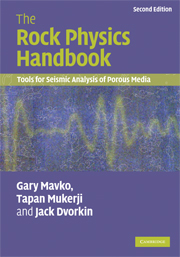Book contents
5 - Granular media
Published online by Cambridge University Press: 19 February 2010
Summary
Packing and sorting of spheres
Synopsis
Spheres are often used as idealized representations of grains in unconsolidated and poorly consolidated sands. They provide a means of quantifying geometric relations, such as the porosity and the coordination number, as functions of packing and sorting. Using spheres also allows an analytical treatment of mechanical grain interactions under stress.
Packings of identical spheres
Porosity
Packing of identical spheres has been studied most, and comes closest to representing a very well-sorted sand.Table 5.1.1 lists geometric properties of various packings of identical spheres (summarized from Cumberland and Crawford, 1987, and Bourbié et al., 1987). The first four rows describe perfectly ordered sphere packs. These are directly analogous to the atomic arrangements in crystals having the same symmetries, although natural sands will never achieve such order. The last row in Table 5.1.1 is for a random, close packing of identical spheres. (Note that complementary interpretations are possible, depending on whether the grains or the pores are considered to be spheres.)
Random packing of spheres has been studied both experimentally and theoretically. Denton (1957) performed 116 repeated experiments of moderately dense, random packings of spheres. His results highlight the statistical nature of describing grain packs (hence the use of the term random packings). He found a mean porosity of 0.391 with a standard deviation of 0.0016. Cumberland and Crawford (1987) found that Denton's porosity distribution over the many realizations could be described well using a beta distribution, and reasonably well with a normal distribution.
- Type
- Chapter
- Information
- The Rock Physics HandbookTools for Seismic Analysis of Porous Media, pp. 229 - 265Publisher: Cambridge University PressPrint publication year: 2009



